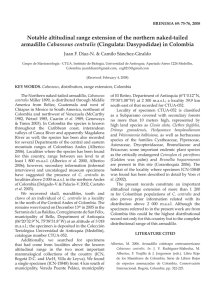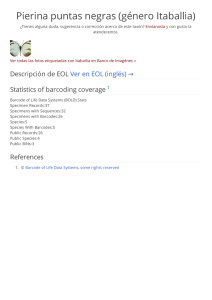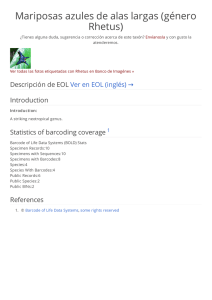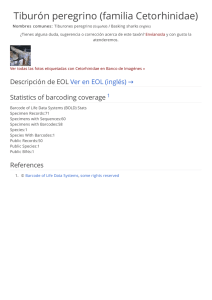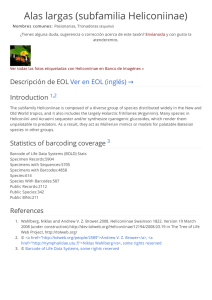Notable altitudinal range extension of the northern naked
Anuncio
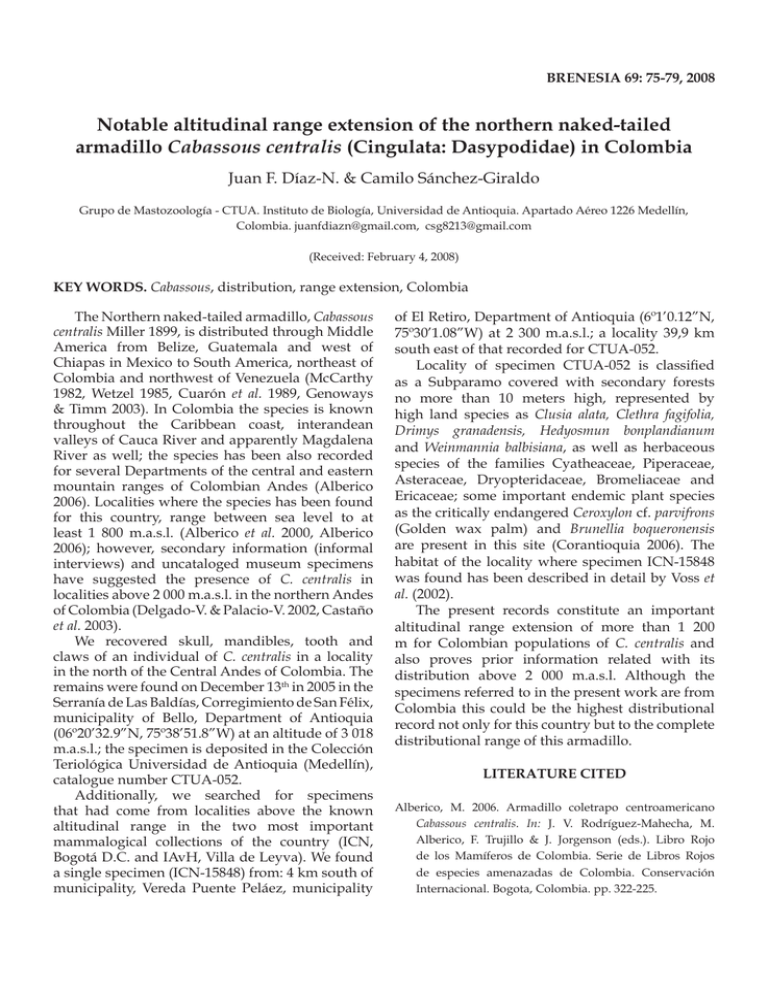
BRENESIA 69: 75-79, 2008 Notable altitudinal range extension of the northern naked-tailed armadillo Cabassous centralis (Cingulata: Dasypodidae) in Colombia Juan F. Díaz-N. & Camilo Sánchez-Giraldo Grupo de Mastozoología - CTUA. Instituto de Biología, Universidad de Antioquia. Apartado Aéreo 1226 Medellín, Colombia. juanfdiazn@gmail.com, csg8213@gmail.com (Received: February 4, 2008) KEY WORDS. Cabassous, distribution, range extension, Colombia The Northern naked-tailed armadillo, Cabassous centralis Miller 1899, is distributed through Middle America from Belize, Guatemala and west of Chiapas in Mexico to South America, northeast of Colombia and northwest of Venezuela (McCarthy 1982, Wetzel 1985, Cuarón et al. 1989, Genoways & Timm 2003). In Colombia the species is known throughout the Caribbean coast, interandean valleys of Cauca River and apparently Magdalena River as well; the species has been also recorded for several Departments of the central and eastern mountain ranges of Colombian Andes (Alberico 2006). Localities where the species has been found for this country, range between sea level to at least 1 800 m.a.s.l. (Alberico et al. 2000, Alberico 2006); however, secondary information (informal interviews) and uncataloged museum specimens have suggested the presence of C. centralis in localities above 2 000 m.a.s.l. in the northern Andes of Colombia (Delgado-V. & Palacio-V. 2002, Castaño et al. 2003). We recovered skull, mandibles, tooth and claws of an individual of C. centralis in a locality in the north of the Central Andes of Colombia. The remains were found on December 13th in 2005 in the Serranía de Las Baldías, Corregimiento de San Félix, municipality of Bello, Department of Antioquia (06º20’32.9”N, 75º38’51.8”W) at an altitude of 3 018 m.a.s.l.; the specimen is deposited in the Colección Teriológica Universidad de Antioquia (Medellín), catalogue number CTUA-052. Additionally, we searched for specimens that had come from localities above the known altitudinal range in the two most important mammalogical collections of the country (ICN, Bogotá D.C. and IAvH, Villa de Leyva). We found a single specimen (ICN-15848) from: 4 km south of municipality, Vereda Puente Peláez, municipality of El Retiro, Department of Antioquia (6º1’0.12”N, 75º30’1.08”W) at 2 300 m.a.s.l.; a locality 39,9 km south east of that recorded for CTUA-052. Locality of specimen CTUA-052 is classified as a Subparamo covered with secondary forests no more than 10 meters high, represented by high land species as Clusia alata, Clethra fagifolia, Drimys granadensis, Hedyosmun bonplandianum and Weinmannia balbisiana, as well as herbaceous species of the families Cyatheaceae, Piperaceae, Asteraceae, Dryopteridaceae, Bromeliaceae and Ericaceae; some important endemic plant species as the critically endangered Ceroxylon cf. parvifrons (Golden wax palm) and Brunellia boqueronensis are present in this site (Corantioquia 2006). The habitat of the locality where specimen ICN-15848 was found has been described in detail by Voss et al. (2002). The present records constitute an important altitudinal range extension of more than 1 200 m for Colombian populations of C. centralis and also proves prior information related with its distribution above 2 000 m.a.s.l. Although the specimens referred to in the present work are from Colombia this could be the highest distributional record not only for this country but to the complete distributional range of this armadillo. LITERATURE CITED Alberico, M. 2006. Armadillo coletrapo centroamericano Cabassous centralis. In: J. V. Rodríguez-Mahecha, M. Alberico, F. Trujillo & J. Jorgenson (eds.). Libro Rojo de los Mamíferos de Colombia. Serie de Libros Rojos de especies amenazadas de Colombia. Conservación Internacional. Bogota, Colombia. pp. 322-225. 76 BRENESIA 68, 2008 Alberico, M., A. Cadena, J. Hernández-Camacho & Y. MuñozSaba. 2000. Mamíferos (Synapsida: Theria) de Colombia. Biota Colombiana 1(1): 43-75. Castaño, J. H., Y. Muñoz-Saba, J. E. Botero & J. H. Vélez. 2003. Mamíferos del Departamento de Caldas – Colombia. Biota Colombiana 4(2): 247-259. Corantioquia. 2006. Componente flora. Plan Maestro del Área de Reserva del Occidente del Valle de Aburra. Tomo I, Generalidades y Dimensión ambiental. U.T. UdeA, HOLOS, Fundación Natura. CORANTIOQUIA. pp. 92-208. Cuarón, A. D., I. J. March & P. M. Rockstroh. 1989. A second armadillo (Cabassous centralis) for the faunas of Guatemala and Mexico. Journal of Mammalogy 70(4): 870-871. Delgado-V., C. A. & J. A. Palacio-V. 2002. Inventario preliminar de los mamíferos no voladores del Cerro el Romeral, El Chupadero, Cerro del Padre Amaya y Miraflores. Corporación Autónoma Regional del Centro de Antioquia. Informe Final. pp. 1-37. Genoways, H. H. & R. M. Timm. 2003. The Xenarthrans of Nicaragua. Mastozoología Neotropical. 10(2): 231-253. McCarthy, T. J. 1982. Chironectes, Cyclopes, Cabassous and probably Cebus in southern Belize. Mammalia 46: 397400. Voss, R. S., M. Gómez-Laverde & V. Pacheco. 2002. A New Genus for Aepeomys fuscatus Allen, 1912, and Oryzomys intectus Thomas, 1921: Enigmatic Murid Rodents from Andean Cloud Forests. American Museum Novitates 3373: 1-42. Wetzel, R. M. 1985. Taxonomy and distribution of armadillos, Dasypodidae. In: G. G. Montgomery (ed.). The evolution and ecology of armadillos, sloths, and vermilinguas. Smithsonian Institution Press, Washington, D.C. pp. 2346.
